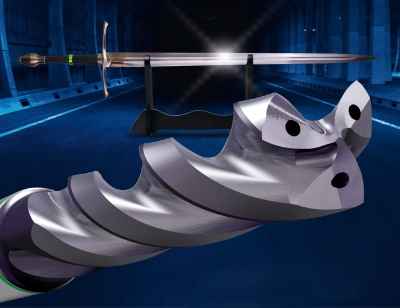
Hoffmann Group USA announced that it has expanded its GARANT MasterSteel (pictured) and HOLEX ProSteel solid-carbide drill ranges to include imperial sizes, thereby further extending its lead over the competition when it comes to machining technology.
“By expanding our GARANT and HOLEX solid carbide drill lines to include imperial sizes, we are backing our commitment to bringing customers the best products in the configurations and sizes that they need,” said Charlie Slagle, president and CEO of Hoffmann Group USA. “We understand that every job is unique, and that every need is not the same. We do our best to bring our customers the biggest variety of options available on the market today.”
In the summer of 2015, the Hoffmann Group USA opened a new performance class for solid-carbide milling cutters with its GARANT MasterSteel HPC milling cutter. With the GARANT MasterSteel FEED, this distinction has now been extended to include solid carbide drills as well. Featuring three flutes, the new GARANT MasterSteel FEED generates up to 50 percent more feed per rotation and offers a particularly long tool life. The GARANT MasterSteel line has been optimized to suit a range of production environments. The 3-flute GARANT MasterSteel FEED reaches its maximum performance on machining centers with a high spindle output and high torque.
The point geometry (for which a patent is pending) reduces the cutting pressure and its 145-degree point angle ensures an optimised chip flow and controlled chip breaking. The tool also boasts outstanding self-centering because the self-centering forces act on three flutes instead of just two. Spot drilling can therefore easily be carried out, even on critical and uneven surfaces. The GARANT MasterSteel FEED is available for diameters of 4 to 20 millimeters and 3/16 to 5/8 inches.
Building on this, Hoffmann Group USA also made its HOLEX ProSteel general-purpose high-performance drills available in solid carbide. The tough substrate and the wear-resistant coating of the HOLEX ProSteel solid-carbide drills stand up to demanding applications. The robust edge geometry and the special flute profile make this drill a true all-rounder. These characteristics permit use on steel into the high-tensile range, on stainless steels and on cast iron.
Contact Details
Related Glossary Terms
- backing
backing
1. Flexible portion of a bandsaw blade. 2. Support material behind the cutting edge of a tool. 3. Base material for coated abrasives.
- centers
centers
Cone-shaped pins that support a workpiece by one or two ends during machining. The centers fit into holes drilled in the workpiece ends. Centers that turn with the workpiece are called “live” centers; those that do not are called “dead” centers.
- feed
feed
Rate of change of position of the tool as a whole, relative to the workpiece while cutting.
- flutes
flutes
Grooves and spaces in the body of a tool that permit chip removal from, and cutting-fluid application to, the point of cut.
- gang cutting ( milling)
gang cutting ( milling)
Machining with several cutters mounted on a single arbor, generally for simultaneous cutting.
- milling
milling
Machining operation in which metal or other material is removed by applying power to a rotating cutter. In vertical milling, the cutting tool is mounted vertically on the spindle. In horizontal milling, the cutting tool is mounted horizontally, either directly on the spindle or on an arbor. Horizontal milling is further broken down into conventional milling, where the cutter rotates opposite the direction of feed, or “up” into the workpiece; and climb milling, where the cutter rotates in the direction of feed, or “down” into the workpiece. Milling operations include plane or surface milling, endmilling, facemilling, angle milling, form milling and profiling.
- milling cutter
milling cutter
Loosely, any milling tool. Horizontal cutters take the form of plain milling cutters, plain spiral-tooth cutters, helical cutters, side-milling cutters, staggered-tooth side-milling cutters, facemilling cutters, angular cutters, double-angle cutters, convex and concave form-milling cutters, straddle-sprocket cutters, spur-gear cutters, corner-rounding cutters and slitting saws. Vertical cutters use shank-mounted cutting tools, including endmills, T-slot cutters, Woodruff keyseat cutters and dovetail cutters; these may also be used on horizontal mills. See milling.
- point angle
point angle
Included angle at the point of a twist drill or similar tool; for general-purpose tools, the point angle is typically 118°.
- stainless steels
stainless steels
Stainless steels possess high strength, heat resistance, excellent workability and erosion resistance. Four general classes have been developed to cover a range of mechanical and physical properties for particular applications. The four classes are: the austenitic types of the chromium-nickel-manganese 200 series and the chromium-nickel 300 series; the martensitic types of the chromium, hardenable 400 series; the chromium, nonhardenable 400-series ferritic types; and the precipitation-hardening type of chromium-nickel alloys with additional elements that are hardenable by solution treating and aging.







